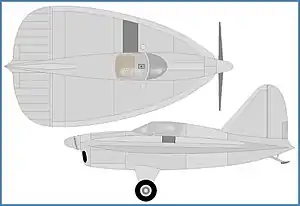Moskalyev SAM-9 Strela
The Moskalyev SAM-9 Strela (Arrow) was a one-off, Soviet, 1930s experimental tailless aircraft designed to test the characteristics of a highly swept, near-delta wing.
| SAM-9 | |
|---|---|
 | |
| Role | |
| National origin | USSR |
| Manufacturer | GAZ-18, Voronezh |
| Designer | Alksandr Sergeyevitch Moskalyev |
| First flight | early 1937 |
| Number built | 1 |
Design and development
As early as 1933, Alksandr Moskalyev was designing a rocket-powered, tailless aircraft with an ogival or gothic delta wing with wingtip fins and rudders, able to fly faster than sound. Because no sufficiently powerful engines were available at the time, the Moskalyev SAM-4 Sigma never left the drawing board but it did lead to two interim types, the SAM-7 Sigma and SAM-9 Strela.[1]
The tailless Strela was built to test the behaviour of the SAM-4's radically new wing plan which, had the leading edges been straight, would have been a highly swept delta. Instead they were moderately convex. Set at shoulder height, the wing reached from the nose ahead of the engine back to mid-fin; including its broad-chord, tab-assisted elevons it reached the extreme tail. It had the unusually low aspect ratio of 0.925. Like the rest of the Strela, the wing structure was wooden. Control surfaces were fabric covered but the rest of the Strela's skin was ply.[1]
Moskalyev had intended to fit a 760 hp (570 kW) Hispano-Suiza 12Y engine in the Strela but only a 270 hp (200 kW) Renault 6P was provided. The Strela's enclosed cockpit was at about mid-chord with a fairing behind it reaching to the large, blunted triangular fin. Its narrower rudder, like the elevons, was tab-assisted.[1]
The Strela had a tall, fixed, conventional undercarriage, with cantilever faired legs based on those of the Moskalyev SAM-5 and a sprung tailskid.[1]
It was first flown, at Voronezh, in early 1937 by A.N.Rybo. A.N.Gusarov and A.P.Chernavskii explored its characteristics over the next few months, finding it controllable but demanding. The high landing angle of attack (20º) of delta-like wing aircraft was not then familiar but worrying. In mid-1937 development of the SAM-9 was terminated.[1]
Specifications
Data from Osprey Encyclopedia of Russian Aircraft 1875-1995[1]
General characteristics
- Crew: one
- Length: 6.15 m (20 ft 2 in)
- Wingspan: 3.55 m (11 ft 8 in)
- Wing area: 13.0 m2 (140 sq ft)
- Aspect ratio: 0.975
- Airfoil: modified RAF 38
- Empty weight: 470 kg (1,036 lb)
- Gross weight: 630 kg (1,389 lb)
- Powerplant: 1 × Voronezh MV-6 inverted 6-cylinder inline, 200 kW (270 hp) (licence-built Renault 6P)
- Propellers: 2-bladed fixed-pitch propeller
Performance
- Maximum speed: 310 km/h (190 mph, 170 kn) maximum achieved at sea level
- Service ceiling: 1,500 m (4,900 ft) maximum achieved
- Take-off run: 200 m (660 ft)
- Landing run 100 m (330 ft)
- Landing speed: 102 km/h (63 mph; 55 kn)
References
- Gunston, Bill (1995). The Osprey Encyclopedia of Russian Aircraft 1875-1995. London: Osprey (Reed Consumer Books Ltd). pp. 251–2. ISBN 1 85532 405 9.